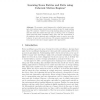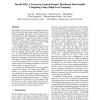1301 search results - page 184 / 261 » Default Clustering from Sparse Data Sets |
ISVC
2010
Springer
13 years 6 months ago
2010
Springer
We present a novel framework to reliably learn scene entry and exit locations using coherent motion regions formed by weak tracking data. We construct “entities” from weak trac...
ICDM
2005
IEEE
14 years 1 months ago
2005
IEEE
In this work, we introduce the new problem of finding time series discords. Time series discords are subsequences of a longer time series that are maximally different to all the r...
JFR
2006
13 years 7 months ago
2006
We derive categories directly from robot sensor data to address the symbol grounding problem. Unlike model-based approaches where human intuitive correspondences are sought betwee...
OSDI
2008
ACM
13 years 10 months ago
2008
ACM
DryadLINQ is a system and a set of language extensions that enable a new programming model for large scale distributed computing. It generalizes previous execution environments su...
CSDA
2006
13 years 7 months ago
2006
The three-mode partitioning model is a clustering model for three-way three-mode data sets that implies a simultaneous partitioning of all three modes involved in the data. In the...


